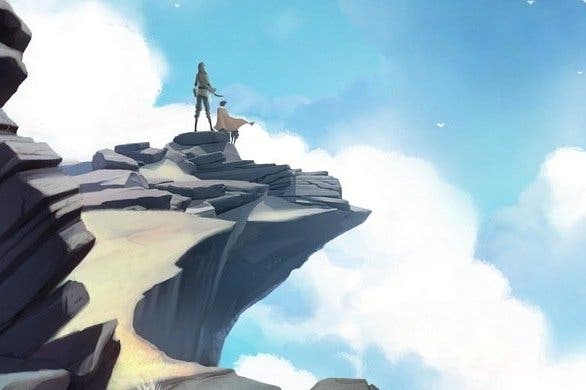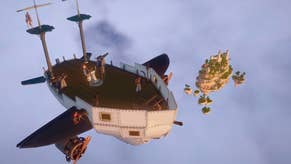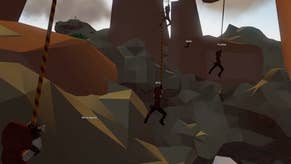Nomad sky: Worlds Adrift is an unusual game
Improbable, even.
I had to see the crash before I understood it in its entirety. All afternoon I had been watching a game that seemed made of fascinating bits and pieces. An MMO about exploration rather than levelling. An homage to The Wind Waker and Skies of Arcadia in which you race around floating islands utilising Icarus wings and a grappling hook. A survival game about crafting and salvage in which every part of harvesting and construction is tangible, in which trees are sliced into individual logs that start to roll away from you the moment they hit the ground. As the ideas piled up, as the logs rolled, and as one of the developers I was sat with took the controls of a huge airship and showed me how you could use the craft's in-game control panel to steer it through the clouds, right down to navigating via the artificial horizon sat snug in its brass orb, I pretty much gave up. I caved and asked what Worlds Adrift is actually about. He couldn't really give me an answer.
And then the airship crashed, and I understood.
It wasn't a straightforward crash, but still: one of the developers used a debug command to delete the airship's spine, and I suddenly realised that everything the ship was made of - all the timbers, the battered plating, the cannons, the B-25 engines strapped incongruously on the sides - were separate physics objects, and they all started to fall, collapsing inwards as the skeleton that held them together disappeared.
Crucially, I was watching the collapse on two monitors - the best way to get a demo of a game like this - and from two separate characters' perspectives. As the ship pieces fell, the developers started to get very excited. And I could see why: the wreckage was exactly the same on each screen, the same pieces falling, witnessed from two different vantage points. When the wreckage hit the ground, it just stayed there, too, once it had come to rest. It didn't fade out. It wasn't replaced with some standardised wreckage mesh. We started to poke through it, and the developer I was sat with explained that every piece we were looking at belonged to that ship we'd been standing on. There wasn't so much as an errant spar thrown in for effect. Nothing had been faked. We could take these pieces and pretty much rebuild the old ship - if we managed to find a new spine for it. Furthermore, if we left this junk where it was, and if another player came by - if another player came by five or six months from now, even - the pieces would still be here. This world remembers things.
Right on cue we looked down and there was the artificial horizon, now lying at the edge of a cliff. A little brass orb. It was still working.
Remember MMOs? That's an initialism that most developers will go out of their way to avoid at the moment - particularly if they're making an MMO. And MMOs have changed a lot, too. Instances have been on the rise. Despite the uptick in big social events, single-player adventuring has been on the rise. In WOW these days, you can own your own bit of Azeroth - but do you really own it, and is it really there, when it's hived off from the rest of the map, carved out in a little pocket of Witchspace?
This is where Worlds Adrift fits in, and it's probably why Bossa Studios, the developer, doesn't seem too afraid of admitting it's an MMO. It's an MMO powered by some fearsome and Cloudy server-side tech that I won't even pretend to understand, that's supplied, I gather, by a company called Improbable. Physics and persistence lie at the core of it, though: the physics is handled on the server-side, which means that when something happens, it's the same something happening witnessed by every player at the same time. Furthermore, when something happens, it stays happened. Crash a ship and walk away and the wreckage will lie where you left it - until somebody else finds it, whoever that may be and whenever that may be.
Bossa Studios, unsurprisingly for a company that has been involved with games about controlling a surgeon's rubbery hand and an adventurous piece of bread, is based in London in prime Blue Ant territory. Peak Blue Ant, so much so that, at any moment, you might expect Hubertus Bigend to crash through a meeting room wall in a Hummer and start handing out Cornettos. He didn't when I was there - probably because there are no meeting room walls in a joint like this! - but still. To get to Bossa, you turn left at the organic soup place and breeze right past the indie bookstore with old Robert Bolano novels piled in the window. Go down the street until you sense that you are in close proximity to people who really care about fonts, and then walk into a building that resembles a prison or an old poorhouse, and probably costs an absolute fortune to lease space inside.
I'll admit I expected a certain degree of pleasant hipster flim-flam, in other words. An irony and detachment. And yet Worlds Adrift is a winningly earnest prospect. It may have an in-game camera that you can apply filters to, but it's also a game about exploring vast spaces in which nothing, really, is faked. The background here is that the land was once ruled by crazed tinkerers who used anti-gravity resources to construct great wonders. They over-reached, of course, and blew themselves to pieces. Now their world survives as chunks of rock floating in thick, volumetric cloud banks. As a player, you're new to all this, and the main thrust of the game is exploring the landscape and picking over the remains of the ancients, hopping from island to island, learning lore and skills from the broken artefacts that you find, and slowly coming to understand how to do more, how to build more, and how to travel further through the gear-gating storms that create boundaries.

The islands are beautiful, a blend of procedural generation and hand-made stuff that is still going through a last few iterations as I visit. A desert island is all dune crests and rippled sand, while a rock island has a flat plateau that gives way to knotty caverns and underground networks: it looks like an old piece of wood that termites have gotten to. Each island contains resources for you to find and use as you progress through a world that revolves around learning how to do new things rather than hitting arbitrary levels, but while trees regrow over time once chopped, many of the resources you're harvesting are finite. You can't grind the same place forever for more knowledge. You have to move on.
Locally, movement is handled by those wings you can produce from a backpack and by a grappling hook, which looks like a delight to use, fired with a mouse pointer and offering the physical flourishes of a Spider-Man movie. It's a multi-use tool, this one, because, in a world that's driven by physics, everything becomes a multi-use tool. At one point. the developer I'm with chops a tree and the trunk starts to roll towards the abyss. He grapples it at the last minute, and as the log rolls, the rope of the grappling hook starts to wind around it. Lovely stuff!
If you want to travel big distances, though, you're going to have to craft an aircraft, a strange collection of wood and tin plating that feels part whaling ship, part 1940s bomber. Again, nothing is faked, and the entire thing is driven by components that can be placed anywhere and removed or destroyed to immediate effect. You need anti-grav modules to keep you aloft, and then you need engines to keep you moving. You also need little pads set up for respawns, placement of which confers ownership of the craft. If people want to take your craft from you, they'll swing aboard - there's no boarding button here, they'll have to attach themselves and make it onto the deck in one piece - and they'll probably target the respawn plates first.
As such, there's going to be a real meta-game evolving around ship combat, I think. Where to put stuff, how to protect it. All the metalwork is clamped on by hand, and I've already seen ships where there are cannons hidden behind plating - and ships that accidentally blew themselves apart as the owners tried to reveal those cannons by blasting through their own hulls - and I've seen ships where the heaviest plating was actually a decoy, and where the precious stuff was kept elsewhere. Beyond that, how do you want to take the enemy? Shoot them to pieces and pick up the salvage where it lands? Or hop on board - daring this - and attach mini-lifters to the parts you want as you slice them off? At one point, a developer leapt onto an enemy ship, chopped off the engine and then floated away on it. Infuriating!

And these enemies are other players, of course: only enemies because they've decided to become pirates, and only fighting you because they think you're weak and that they will win. There's a little of Eve Online to Worlds Adrift, not least because it favours really big shards - not quite a single global pool of players, but still: everyone on a continent playing together on a vast terrain with lots of space between people. When I ask if the physics and the persistence that lies at the heart of the game will make it a perfect place for griefing, the answer suggests that a kind of balancing should hopefully be in effect. It's going to take a lot of work before you're powerful to take on anybody else, and by that point, you'll hopefully have better things to do - and you'll also have a lot to lose.
And from there we're back into the bits and pieces that make up a game such as this. I'm taken with the idea that you can stick the instruments to your ship anywhere you want, so that you could have a crew, say, and each person in that crew does a different job. I'm taken with the idea that, if you're quick on the draw, you can grapple yourself onto cannonballs as you fire them and shoot yourself at the enemy.
Mostly, I'm taken with the underlying cleanness of the concept, once I worked out what it truly was: that players are going to make wreckage as they play that will create a shifting topsoil for other players to pick over. This is a game about archaeology, as much as it's a game about anything, and only the very bottom layer - the ancients and their terrible tragedy - has been prepared in advance.










.png?width=291&height=164&fit=crop&quality=80&format=jpg&auto=webp)



